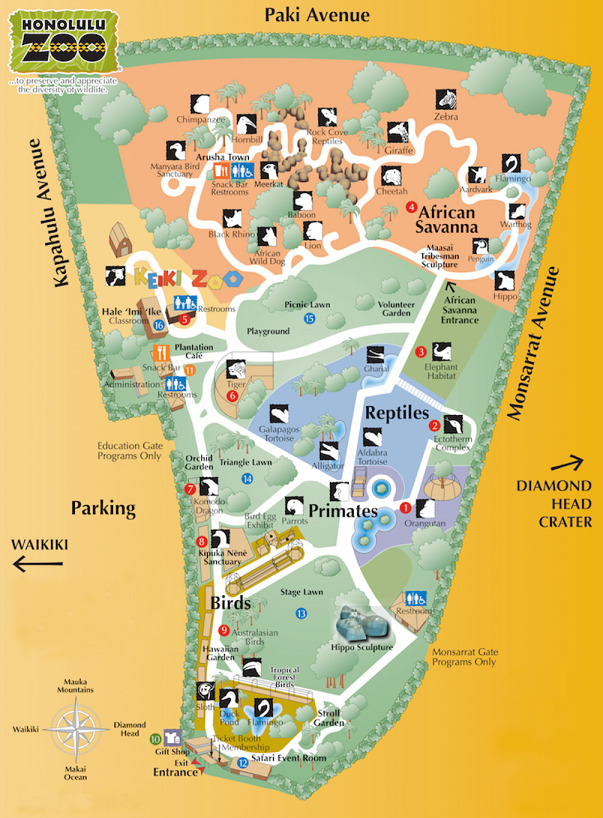ALOHA from O'ahu
---Honolulu Zoo---


Around 600,000 people visit the Honolulu Zoo annually. It is the largest zoo within a radius of 2,300 miles and unique in that it is the only zoo in the United States originating from a King's grant of royal lands to the people. King David Kalākaua, Monarch of Hawai'i from 1874 to 1891, made lands of the Leahi Land Holdings available in 1876 to the people for a thirty year lease. That year, a "Kapi'olani Park Association" of two hundred subscriber members assumed the administration of the three hundred-acre park. The marshy parcel was a muddle of fishponds, lagoons and islands where King Kalakaua maintained his collection of exotic birds. In 1877 the area was named after the King's wife and opened as Queen Kapi'olani Park.
Park Association members supported the unpromising park with the help of royal grants through 1894. In those days, the park's primary attractions were the exotic bird collection and horse racing, especially the running of the Rosita Cup, held annually on King Kamehameha Day.
Peacocks, trees, and palms were added to the park, with plantings obtained from Golden Gate Park in San Francisco. Roads and trolley lines were extended to include "Waikiki Road at Makee", today's intersection of Kalākaua and Kapahulu Avenues. The park was permanently established in 1896 and the City and County of Honolulu assumed administration of city parks in 1914. Today, the zoo continues under the administration of the City, but as a part of the Department of Enterprise Services.

During 1914 to 1916, the young administrator of Parks and Recreation, Ben Hollinger began collecting animals for exhibit at Kapiolani Park. The first animals included a monkey, a honey bear and some lion cubs. In 1916 Daisy, a friendly African elephant arrived in Honolulu on the Niagra, a steamship on it's way from Australia to Canada transporting animals for mainland zoos and circuses. Ben Hollinger, pictured at right with Daisy, persuaded city merchants to purchase Daisy and for years she delighted Honolulu children. Many recall riding as a youngster around the park on her back.

Daisy's career ended tragically in 1933, when for unexplained reasons, she attacked and trampled to death her keeper George Conradt. She was put down by police marksmen and buried at sea. Pictured left are Daisy and her keeper George Conradt.
During the Depression years, the Zoo faltered and nearly closed. Additional animals still came to the zoo, including the following animals purchased from an animal dealer to arrive November 29, 1949 aboard the freighter, the American Wholesaler, out of Los Angeles: a giraffe, an ostrich, emus, an elephant, a Bactrian camel, 3 sea lions, several other bird species, spider monkeys and a tortoise. However, the grounds and facilities continued to fall into disrepair. In 1947, the donation of a camel, elephant, chimpanzees and deer by the Dairymen's Association sparked a renewal for the Honolulu Zoo. During this time the City took important steps to set the course for today's Zoo. It approved a Master Plan that determined the boundaries of the present 42-acre site at the north end of Kapi'olani Park. It hired its first full-time director, Paul Breese, and a staff of thirteen. The animal collection, increased by purchase, trade and donations, was housed in newly constructed facilities, some of which still provide foundations for newer exhibits. In 1952 the Zoo's design was revised, and again modified to take on the shape and form seen in the "old zoo" exhibits like the small mammal row along Kapahulu Avenue. The Honolulu Zoo experienced another revival of enthusiasm in the 1990s as the exhibits were redesigned to feature more natural settings for the animals on display.
You DO NOT need to enter the Zoo to find the cache.
~~~For the puzzle, know your animals.~~~
Cache is at:
NORTH:
Eastern Tiger Salamander
Common eastern firefly
Diana Fritillary Butterfly
Sperm whale
WEST:
Viceroy Butterfly
Astrodon johnstoni
Bowhead whale
American Goldfinch
Brown Thrasher

You can validate your puzzle solution with certitude.
 Cache with Al
Cache with Al ha
ha
Congrats tennyogirl on the FTF!!!